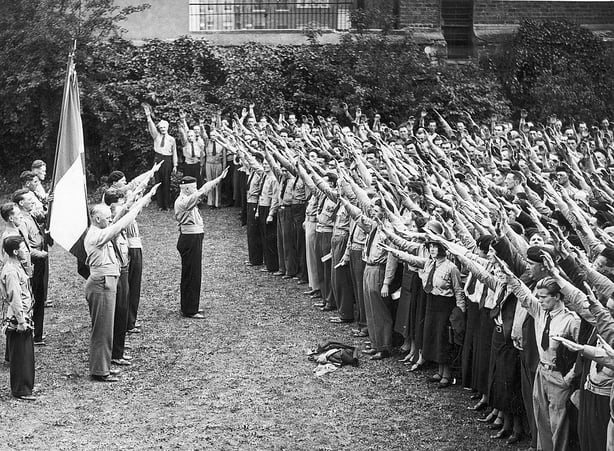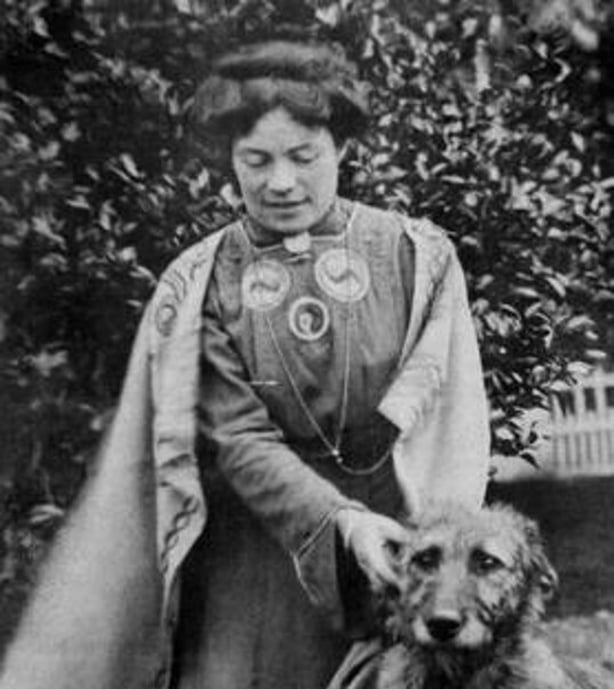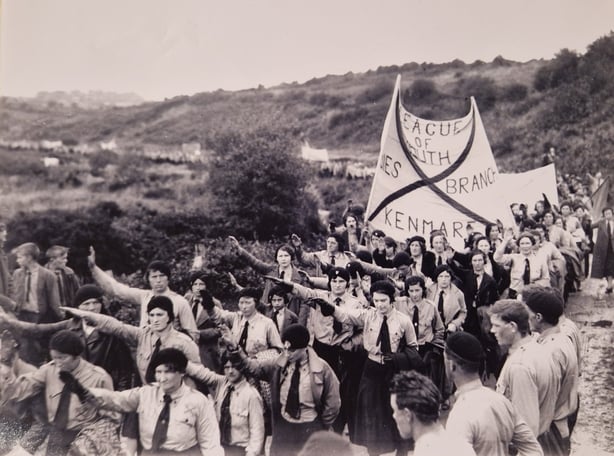Analysis: the vehemently anti-republican women who were involved in the proto-fascist Blueshirts, banned 90 years ago this month, are still missing from our national narrative
By Mary McAuliffe, UCD
Senator Kathleen Browne, a member of the Irish Free State from 1927 to 1936, had participated with her local Cumann na mBan in south Wexford in the War of Independence, was pro-treaty and member of Cumann na Saoirse during the Civil War. But unlike many of the political and militant women of the Irish revolution, Browne’s afterlife was not one of involvement in feminist organisations, or in campaigns to allay the restrictive legislation on women’s participation, outside the home, in the Free State. Indeed Brown, an avid supporter of W.T. Cosgrave and Cumann na nGaedheal was more anxious about the rise of Fianna Fáil than the chipping away at women’s rights under the Cosgrave Government.
One of the organisations she became associated with after the Finna Fáil electoral success in the 1932 General Election was the Army Comrades Association. The ACA was an organisation of former members of the National Army, which was formed in 1932 in opposition to de Valera’s Government and provided protection for members of Cumann na nGaedheal.
Political meetings were fractious and often violent, with running clashes between the ACA and republicans who supported Fianna Fáil. By July 1933 the ACA had adopted a uniform, of a blue military style shirt and the straight arm salute, and renamed itself the National Guard under the leadership of former Garda Commissioner, General Eoin O’Duffy. The National Guard was better known by their nickname, the Blueshirts.
We need your consent to load this rte-player contentWe use rte-player to manage extra content that can set cookies on your device and collect data about your activity. Please review their details and accept them to load the content.Manage Preferences
From RTÉ Archives, Blueshirts declared unlawful in 1933 by President of the Executive Council of Dáil Éireann, Éamon de Valera (broadcast July 1974)
Originally a male only organisation, women soon became involved in large numbers. Like the men, they also adopted a uniform, a military style blue blouse with dark blue beret and tie, and dark skirt. They were referred to sometimes as girl Blueshirts, but more often they were called the Blue Blouses. Dale Montgomery, in his study of Blue Blouses, estimated that there were 12,500 Blue Blouse women involved in 628 branches throughout the country at its height; although most were concentrated in rural areas of Kerry, Cork, Tipperary, Kilkenny, Meath, Carlow and Dublin. In his study on the Blueshirts in Kerry, historian Owen O’Shea found the presence of Blue Blouse branches in several areas including Listowel and Kenmare.
In Wexford, Kathleen Browne was a senior member and she recruited hundreds of men and women into the organisation. What motivated Browne and the men and women she recruited was, she said in a Senate speech, securing order, peace and discipline in the country. While Dr Kathleen Lynn wrote in her diaries that the 'A.C.A. [who] call themselves 'National Guard' [are] Blue Shirts = kind of Fascisti’, Browne insisted that ‘ours is not a fascist movement’, although she did not offer any criticism of fascism, instead seeing Communism (and Fianna Fáil, which she regarded as infected by Communism), especially groups such as the Friends of Soviet Russia (of which Lynn was a member) and their ‘poisonous propaganda’, as a real danger to Ireland.

These concerns motivated many thousands of women and by 1933 there were more women in Blue Blouse branches than there were in Cumann na mBan, in the Irish Countrywomen’s Association and in the remaining feminist organisations. The conservative, patriarchal politics of the Blueshirt movement were not a deterrent, and in many ways the involvement of women in the Blue Blouses mirrored the more domestic roles which Cumann na mBan played before and during the War of Independence. They were also vehemently anti-republican and older members, like Browne, would have been in the short lived pro-treaty women’s group, Cumann na Saoirse.
Like the Blueshirts, the Blue Blouses were generally social conservatives, determined to defend the State from what they perceived as the threat of IRA extremism. For women like Browne, a self-declared practical farmer, it was also about defending the rights of the farming community from which she sprang, defending the right to free speech and about the provision of a stalwart defence against the rise of communism and the possible threat of dictatorship. Many supporters of the Blueshirts felt that a Fianna Fáil government would interfere with the rule of law and order in the country, would allow those who had been anti-Treaty take revenge on the pro-Treaty supporters, but most especially, many like Browne were concerned with the effects of the Economic War on the country, particularly on rural Ireland.

As well as supporting the Cumann na nGaedheal party, especially as it was now in opposition, Blue Blouse women were the organisers of almost all cultural, social, sporting and fund-raising events, as well as recruitment and propaganda and voter registration. However, they were also deeply involved in party politics and were highly visible at most public meetings around the country. They often appeared in their hundreds at these meetings, distinctive in their uniforms, marching in formation and giving the straight-armed salute. For instance, on March 6, 1935, it was reported thousands of Blueshirts, including about '600 girls', met General O’Duffy a mile outside Galway and ‘escorted’ him into the city for a monster meeting. At Skibbereen, Co Cork on February 2, 1934, 1,000 Blue Blouses marched, while later that year in September, around 3,000 Blue blouses marched at Béal na Bláth to commemorate Michael Collins.
This public visibility meant that the Blue Blouses were exposed to the violence which was part and parcel of political meetings at this time. In early July 1934, Fianna Fáil gathered to celebrate the county council election results and over 80 Blueshirts and a number of Blue Blouses, who were at a public dance, clashed. One of the Blue Blouse girls was badly hurt. When these clashes occurred, attempts were sometimes made to strip the women of their blouses. In Ballincollig District Court in Cork, in early May 1934 a young man was found guilty of tearing the blue blouse and scarf of a woman at a Blueshirt meeting. The United Ireland newspaper reported on June 9, 1934, that a 'girl Blueshirt' was attacked and received a severe beating and ‘her blue shirt was practically torn off her’.

There is also evidence of clashes between Blue Blouse women and other political women. On April 30, 1934, at a meeting held by the Women Prisoners' Defence League, at which Maud Gonne McBride was speaking, two Blue Blouse women were assaulted. According to newspaper reports the girls received ‘rough treatment’ and one had her coat torn off. They had to be rescued from the crowd by the Gardaí. At a court case in Westmeath in June 1934 a woman was charged with assaulting two Blue Blouses, calling them worse than Black and Tans. The Blue Blouses shouted ‘To hell with the Spaniard (de Valera)’ when passing and so provoked the woman.
Street fights were not the only fights Blue Blouses engaged in. Senator Browne challenged the Government by insisting on wearing her blue blouse uniform in the Senate and had similarly attired visitors in the gallery. When her visitors were refused entry into the gallery, Browne provoked a quarrel between the speakers of the Senate and the Dáil. In March 1934, she participated in the debate on the Wearing of Uniform (Restriction) Bill, which sought to ban the wearing of uniform in public life and gave a staunch defence of the Blueshirt organisation. She said the Blue Shirt movement is not an army even if it had a distinctive dress. It was, she argued, the political opposition and entitled to do politics as it saw fit, while the only army was the IRA, an armed revolutionary body determined to ‘overthrow the State by force of arms’.
Read more: Why there would be no Fine Gael without the Blueshirts
Despite the huge numbers of men and women who joined the Blueshirts and Blue Blouses the organisation began to disintegrate in 1935, having been declared illegal by de Valera on December 8, 1933. The ACA, National Guard, National Centre Party and Cumann na nGaedheal had amalgamated in September 1933 to form Fine Gael under O'Duffy’s leadership. Issues such as lack of electoral success in the 1934 local elections and providing no obvious solutions to the Economic War led to O’Duffy’s departure as leader. Most Blueshirts and Blue Blouses remained supporters of Fine Gael, with the wearing of the uniform becoming less common and a steep decline in Blue Blouse membership; by 1936 Montgomery estimates that only 890 women remained as members.
While the Blue Blouse organisation did not last very long it was an important demonstration that there was a deep conservatism among Irish women. Historians most often write about the radical revolutionary women, the first wave feminists, the socialist women, those who challenged the patriarchal, faith-based conservatism of the Free State. But the strength of numbers in the Blue Blouses, at their height, indicates a strong support among women, particularly rural women, for the State and its policies.
We need your consent to load this rte-player contentWe use rte-player to manage extra content that can set cookies on your device and collect data about your activity. Please review their details and accept them to load the content.Manage Preferences
From RTÉ Archives, following her death in Liverpool at the age of 94, the state funeral for Kathleen Clarke takes place in Dublin (RTÉ News report broadcast on 3 October 1972)
Kathleen Browne sat in the Senate with feminists Jennie Wyse Power, Eileen Costello, and Kathleen Clarke, yet unlike them she played no part in resisting the anti-women policies and legislation introduced by both Cumann na nGaedheal and Fianna Fáil governments. Like most Blue Blouses she was socially and political conservative, concerned with the impact of policies on farms and adopting an anti-republican, pro-farmer ideology. While her sister senators were concerned with the rights of the women worker, Browne was more concerned with ameliorating taxation on the egg money earned by farm wives. Like most Blue Blouses she supported the marital, domestic, and reproductive model of wife and mother as the ideal Irishwoman. They would not, and Browne did not, have any objection to the ‘women in the home’ articles which were introduced into the Constitution in 1937.
Read more: Goodbye to Ireland's 'women in the home' constitution clause?
While the histories of left-leaning political women of this period have been recovered, the women who were pro-Treaty, anti-republican, and subsequently involved in the Blueshirts, are still, for the most part missing from our national narrative. Researching the beliefs and ideologies of those women and men, whose convictions led them into proto-fascist organisations, leads to fuller understanding of the political, social, and economic histories of the period.
The views expressed here are those of the author and do not represent or reflect the views of RTÉ

